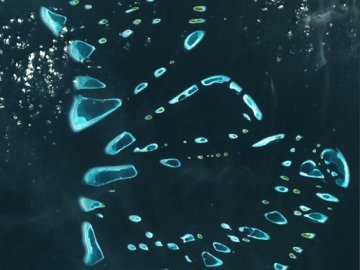Coral islands survive a tsunami
Tiny islands far out in the ocean can weather the giant waves of a tsunami.
Tiny coral-reef islands far out in the ocean may seem fragile. But scientists now know that they aren’t so easily swept away.
 |
|
The December 2004 Sumatran tsunami battered, but didn’t break, the 1,192 atolls of the Maldives. This image, taken by NASA’s Terra spacecraft, shows some of the atolls.
|
| NASA/GSFC/ASTER Science Team |
In December 2004, a large, undersea earthquake rumbled in the Indian Ocean off the coast of Sumatra. The earthquake triggered a tsunami, or a series of large, destructive waves, that traveled across the ocean in all directions (see “Wave of Destruction”).
The Maldives, a nation of about 1,200 islands southwest of India, were in the tsunami’s path. The islands of the Maldives are made up of coral reefs built on top of the craters of a range of undersea volcanoes. The land surface, which is coral and sand, is just above sea level.
 |
|
The Maldives are a group of coral islands resting on top of an ancient volcanic mountain range off the coast of India.
|
| NASA |
The 2004 tsunami was devastating to the people of the Maldives. It flooded many of the islands and left 80 people dead.
Scientists had worried that the tsunami might badly damage the land surface, too, by permanently sweeping away much of the islands’ sand.
But when researchers went back to study the sand depths and new shorelines, they found that the islands themselves had survived. The waves carved away parts of the sandy cliffs and beaches on one side of the islands but put sand back on the opposite coast.
That’s similar to the effect of monsoon winds. The winds blow across the islands in one direction in summer and in the opposite direction in winter, moving sand back and forth between the two coasts. The sand changes places but doesn’t disappear.
The islands’ remoteness may have helped protect them, the researchers say.
The tsunami waves that hit the Maldives were only one-fifth the height of the ones that swept over Thailand. That’s because tsunami waves grow taller as the sea gets shallower, which occurs near a large land mass or a continent. But in the deep ocean around the reef islands, the waves didn’t have time to grow to great heights.—C. Gramling
Going Deeper:
Gramling, Carolyn. 2006. Still standing: Tsunamis won’t wash away Maldives atolls. Science News 169(March 25):181. Available at http://www.sciencenews.org/articles/20060325/fob5.asp .
You can learn more about the Maldives and how wind and waves shape these coral islands at earthobservatory.nasa.gov/Study/Maldives/ (NASA).
Sohn, Emily. 2005. Forests as a tsunami shield. Science News for Kids (Nov. 2). Available at http://www.sciencenewsforkids.org/articles/20051102/Note2.asp .
______. 2005. Wave of destruction. Science News for Kids (Jan. 19). Available at http://www.sciencenewsforkids.org/articles/20050119/Feature1.asp .
______. 2005. Digging into a tsunami disaster. Science News for Kids (Jan. 12). Available at http://www.sciencenewsforkids.org/articles/20050112/Note2.asp .







